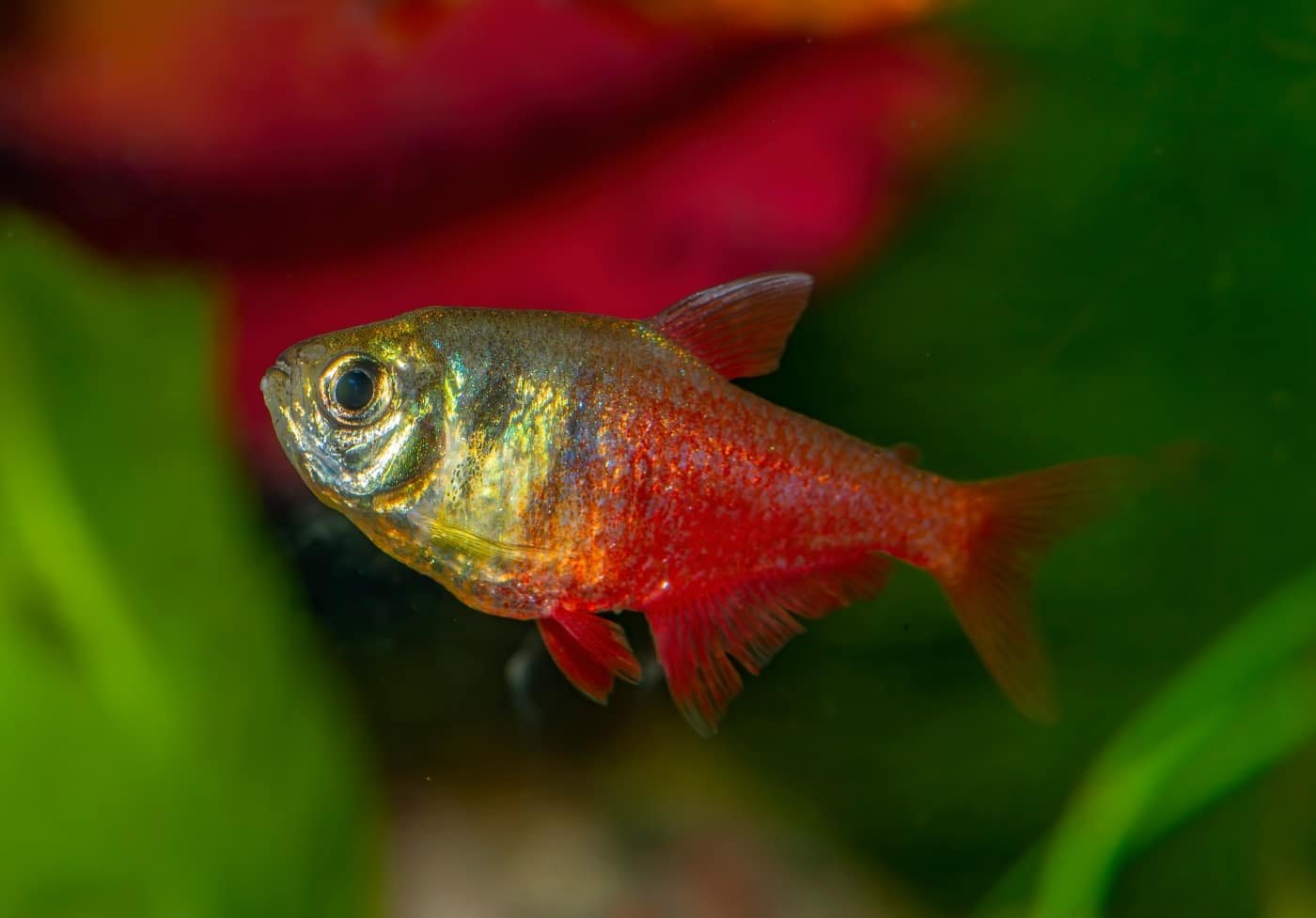The Rainbow Tetra, known scientifically as Nematobrycon lacortei, is a stunning freshwater fish that captivates aquarium enthusiasts with its vibrant colors and dynamic behavior. This species, hailing from the clear waters of Colombia, is a true gem for both novice and experienced aquarists. In this comprehensive guide, we delve into everything you need to know about the Rainbow Tetra, from its natural habitat and behavior to care requirements and breeding tips.
Introduction to the Rainbow Tetra
The Rainbow Tetra is renowned for its iridescent hues, which shimmer under aquarium lights, adding a splash of color to any tank. This small yet lively fish typically grows to about 2 inches in length and is known for its peaceful demeanor, making it an excellent choice for community tanks.
Natural Habitat
Native to the slow-moving rivers and streams of western Colombia, the Rainbow Tetra thrives in environments rich in vegetation and leaf litter. These natural habitats provide ample hiding spots and a wealth of microorganisms that form part of their diet. The water in these regions is typically soft, slightly acidic, and well-oxygenated, conditions that should be replicated in the home aquarium to ensure the health and well-being of these fish.
Appearance and Coloration
One of the most striking features of the Rainbow Tetra is its vibrant coloration. The body of the fish is adorned with shades of blue, green, and red, creating a dazzling display that shifts and changes as the fish moves. Males are generally more colorful than females, exhibiting brighter hues and longer fins. This sexual dimorphism is particularly evident during the breeding season when males display their most intense colors to attract females.
Setting Up the Ideal Aquarium
Creating an optimal environment for Rainbow Tetras involves mimicking their natural habitat as closely as possible. Here are the key factors to consider:
Tank Size
While Rainbow Tetras are relatively small, they are active swimmers and thrive in groups. A minimum tank size of 20 gallons is recommended to provide ample space for a school of six to eight tetras. Larger tanks are even better, as they allow for more stable water conditions and more elaborate aquascaping.
Water Parameters
Maintaining appropriate water parameters is crucial for the health of Rainbow Tetras. The ideal conditions are:
- Temperature: 72-79°F (22-26°C)
- pH: 6.0-7.5
- Hardness: 2-10 dGH
Regular water changes and the use of a good-quality filter are essential to keep the water clean and free from harmful substances. Additionally, it’s beneficial to use a water conditioner to remove chlorine and other chemicals from tap water.
Substrate and Decorations
A dark substrate, such as sand or fine gravel, helps to highlight the vibrant colors of Rainbow Tetras. Adding plenty of live plants, driftwood, and leaf litter creates a natural-looking environment and provides hiding places that help reduce stress. Floating plants can also be added to diffuse the light and create shaded areas, mimicking the dappled sunlight of their native habitat.
Lighting
Moderate lighting is ideal for Rainbow Tetras. Too much light can stress the fish and wash out their colors, while too little can hinder the growth of live plants. Using a timer to ensure a consistent light cycle of 8-10 hours a day helps maintain a stable environment.
Diet and Feeding
Rainbow Tetras are omnivores with a preference for a varied diet. In the wild, they feed on small insects, crustaceans, and plant matter. In the aquarium, a combination of high-quality flake food, pellets, and live or frozen foods such as brine shrimp, daphnia, and bloodworms ensures they receive all the necessary nutrients.
Feeding Tips
- Frequency: Feed small amounts two to three times a day.
- Variety: Rotate different types of food to prevent dietary deficiencies and keep the fish interested.
- Observation: Monitor the feeding habits and adjust the quantity of food to prevent overfeeding, which can lead to poor water quality and health issues.
Social Behavior and Tank Mates
Rainbow Tetras are peaceful and social fish that thrive in groups of six or more. Keeping them in schools not only enhances their natural behavior but also makes them feel more secure. They get along well with other small, non-aggressive species, making them perfect candidates for community tanks.
Compatible Tank Mates
When selecting tank mates for Rainbow Tetras, consider species with similar size and temperament. Good choices include:
- Other Tetras: Species like Neon Tetras, Cardinal Tetras, and Black Skirt Tetras.
- Rasboras: Harlequin Rasboras and Lambchop Rasboras.
- Corydoras Catfish: Peaceful bottom dwellers that complement the mid-to-upper level swimming of tetras.
- Small Gouramis: Dwarf Gouramis and Honey Gouramis.
Avoid Aggressive Species
It’s important to avoid housing Rainbow Tetras with aggressive or much larger fish, as this can lead to stress, injury, or even death. Species to avoid include:
- Cichlids: Except for the smallest and most peaceful varieties.
- Large Barbs: Such as Tiger Barbs, which can be nippy and aggressive.
- Large Catfish: That might view the small tetras as prey.
Breeding Rainbow Tetras
Breeding Rainbow Tetras can be a rewarding experience for aquarists. With the right conditions and a little patience, you can successfully raise a new generation of these beautiful fish.
Breeding Tank Setup
To encourage breeding, set up a separate breeding tank with the following specifications:
- Tank Size: 10-15 gallons.
- Water Parameters: Slightly warmer water (around 78-80°F) with a pH of 6.0-6.5.
- Substrate and Plants: A layer of fine-leaved plants or spawning mops to provide a place for the eggs to be laid and protected.
- Lighting: Dim lighting to reduce stress and mimic natural breeding conditions.
Breeding Process
- Conditioning: Feed the breeding pair a high-protein diet of live and frozen foods for a week or two to condition them for spawning.
- Pair Selection: Choose a healthy male and female. The male will display more intense colors and longer fins.
- Spawning: Introduce the pair to the breeding tank. The male will court the female with a series of displays and chases. Once the female is ready, she will lay eggs among the plants or spawning mop, which the male will then fertilize.
- Egg Care: After spawning, remove the adults to prevent them from eating the eggs. The eggs will hatch in about 24-36 hours, and the fry will become free-swimming within a few days.
- Raising Fry: Feed the fry infusoria or commercially available liquid fry food for the first week. As they grow, gradually introduce newly hatched brine shrimp and finely crushed flakes.
Health and Disease Prevention
Rainbow Tetras are generally hardy, but like all fish, they can be susceptible to certain diseases. Maintaining optimal water conditions and a balanced diet is the best way to prevent health issues.
Common Diseases
- Ich (White Spot Disease): Characterized by white spots on the body and fins. Treat with a commercial ich treatment and raise the water temperature slightly.
- Fin Rot: Symptoms include frayed or disintegrating fins. Caused by poor water quality or bacterial infection. Improve water conditions and use antibacterial medication.
- Fungal Infections: Appear as white, cotton-like growths on the body. Treat with antifungal medication and maintain clean water.
Preventative Measures
- Quarantine New Fish: Always quarantine new fish for at least two weeks before introducing them to the main tank to prevent the spread of disease.
- Regular Maintenance: Perform regular water changes (20-30% weekly), clean the substrate, and check the filter to maintain water quality.
- Observe Behavior: Regularly observe your fish for any signs of illness or abnormal behavior. Early detection is key to effective treatment.
Conclusion
The Rainbow Tetra is a captivating addition to any freshwater aquarium, offering a burst of color and lively activity. By providing the right environment, diet, and care, you can enjoy the beauty and charm of these fish for years to come. Whether you’re a beginner or an experienced aquarist, the Rainbow Tetra is sure to add a touch of brilliance to your aquatic world.
Discover more from EMMOCEB
Subscribe to get the latest posts sent to your email.






